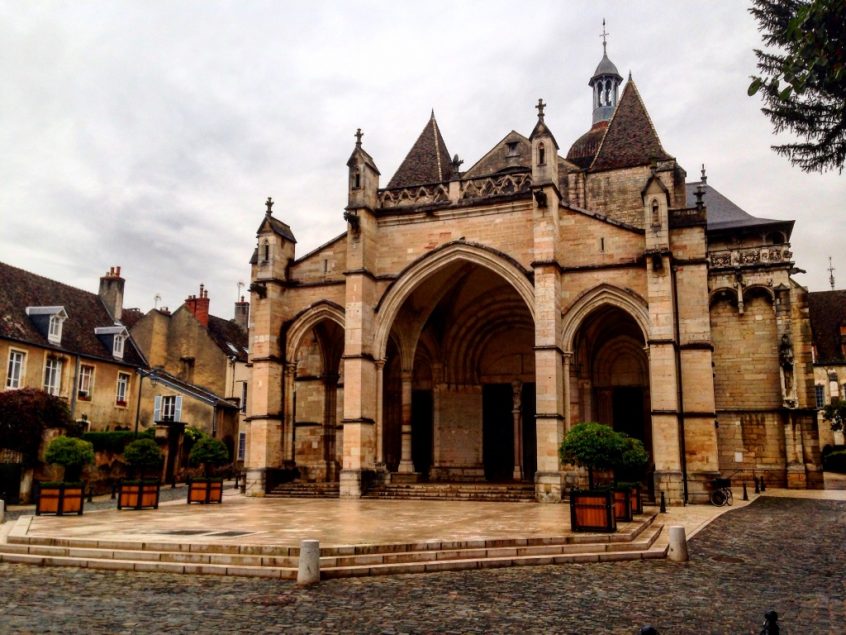A Day in Beautiful Beaune
The city of Beaune is situated in the mid-east of France, roughly halfway between Geneva and Paris. It is one of the two most famous cities in Burgundy, the other being Dijon. Unlike Dijon however, Beaune is smaller and has a wonderful ‘village feel’ about it.

Google Maps indicating Beaune’s situation
Much of the city’s tourism centres around Burgundy’s wine industry, its World Heritage acknowledgement and its AOC for Pinot Noir and Chardonnay varieties. Beaune is the starting point of many wine tours, tasting visits and trips to small surrounding villages. However, I fell in love with Beaune itself and can’t wait to return!
A Beautiful City to Explore by Foot
While exploring the centre of the city on foot, you’ll find many tiny laneways, old-style buildings, homes and businesses as well as several places to taste (degustation) the wines and other specialities of the region. Enjoy an afternoon discovering specialist boutique stores, from hats (chapeaux) and bags to books, cheese, chocolate and bread.

Old-style buildings

Bookstore

Goats Cheese (Chevre) at Fromagerie Alain Hess
Make sure you take a look as some of the city’s “Caves”, or underground cellars. Beaune has dozens of kilometers of cellars, belonging to several different owners, housing decades of wine from the region.

Stairs down to one of the cellars (caves). Each stair has that name of one of the wine-producing towns in the region

Collégiale Notre-Dame
The Collégiale Notre-Dame is Beaune’s cathedral and a beautiful feature in the city’s landscape.
I would have been happy to just wander around the city all day, window-shopping in the small boutiques, sipping tea in the quaint, welcoming cafés and admiring the typically old-style French architecture. Then I happened upon L’Hôtel Dieu, part of Les Hospices Civils de Beaune.
L’Hôtel Dieu, and, Les Hospices Civils de Beaune
L’Hôtel Dieu was opened in 1443 by Nicolas Rolin and his wife Guigone de Salins as a home (hospital) for poor sick people – Les Hospices Civils de Beaune. Les Hospices (hospital) is still in operation today, although in new head quarters. L’Hôtel Dieu buildings themselves continued to be used as a hospital until 1971 but have now been turned into a magnificent museum, inclusive of a wonderfully informative audio guide.

Courtyard of L’Hôtel Dieu

Model of L’Hôtel Dieu
Much of L’Hôtel Dieu is set up as it would have been for various periods during its 600-year use as a hospital, from the great hall for the poor, to the pharmacy with old stils used to distil medicines, the kitchen where food for 100s of people was prepared and the washing station where all the laundry was carried out.

The Great Hall for the Poor, L’Hôtel Dieu

Kitchen of L’Hôtel Dieu

Pharmacy, L’Hôtel Dieu
The unique thing about L’Hôtel Dieu is that everything in the, now museum, are originals from L’Hôtel Dieu as over 2500 pieces of furniture and another 2500 objects (tapestries, paintings, medical bits and pieces) have been conserved over the centuries and now displayed in the museum.
Most of the Hospital’s contents have been donated over the centuries. Other donations and bequests include several domaines (vineyards) in some of the best appellations (regions) of Burgundy. The wine produced from these vineyards has been sold for centuries (and continues to be sold) to raise money for the operation of the Hospital.
Musée du Vin de Bourgogne (Burgundy Wine Museum)
Burgundy (Bourgogne) in France is world-renowned for its wines. Wine has been produced in the region for over 2000 years. Its Appellation d’Origine Contrôlée (AOC) was awarded in 1936 and describes the regions or climats that produce Grand Crus wines, Premier Crus wines, Villages wines and Régionales wines. These climats are geographic regions with specific natural conditions that remarkably affect the grapes’ growth and flavour. Read about my experience picking and stomping grapes in Burgundy with vigneron Frederic Mazeau.

The Musée du Vin de Bourgogne
The Musée du Vin de Bourgogne is situated in the beautiful and prestigious Beaune residence of the Dukes of Burgundy which in itself is a piece of typical Burgundian architecture. The museum (mostly in French) takes you through the history of wine in the Burgundy region, from over 2000 years ago (ceramic roman pots) to today (400 years of glass wine bottles and awarding of World Heritage in 2015). You can find out how winemaking and grape-growing has changed over the centuries with introduction different technologies and see where the appellations are located in the region of Burgundy.

Vine maintenance equipment at the Musée du Vin de Bourgogne

A handful of wine bottles, over the centuries, Musée du Vin de Bourgogne
Musée des Beaux-Arts De Beaune (Fine Arts Museum)
The Musée des Beaux-Arts de Beaune is a small museum exhibiting works from Beaune artists such as Félix Ziem and Hippolyte Michaud as well as collections from Dutch and Flemish painters and lithographs by Picasso, Fernand Léger and Le Corbusier. There is also a second section focussing on art and publications (posters, advertisements and photographs) centred around Beaune’s wine history.
Worth a note: L’Hôtel Dieu, Musée du Vin de Bourgogne and the Musée des Beaux Arts offer a great value combined entry ticket which is worth purchasing if you intend to visit all three sites.
I do hope you enjoy exploring and experiencing Beaune as much as I did!

